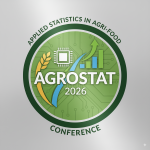|
|
|
Themes
The themes of AgroStat 2026 are:
- Data quality, reliability and reproducibility includes data acquisition and preprocessing (such as noise, outliers, missing values and representativeness), as well as model validation and robustness (cross-validation, experimental design, quality of training data in AI, and explainable AI). It also covers data management and governance, with attention to FAIR principles, metadata, open data, reproducible computation and open science practices.
- Heterogeneous data integration and fusion includes multiblock and multiview methods (PLS, RGCCA, sparsity and high-dimensional settings), and the fusion of multi-source and multi-scale data such as chemical, sensory, consumer, omics, imaging and spectroscopic datasets. Both supervised and unsupervised approaches for analyzing heterogeneous datasets are included, as well as multimodal analysis and real-time processing pipelines for complex data.
- Text analytics and knowledge engineering includes the development and use of ontologies and structured knowledge, the fine-tuning and adaptation of Large Language Models, performance evaluation, bias and robustness, as well as hybrid approaches combining LLMs and ontologies (e.g., RAG, symbolic reasoning and question answering). It also covers NLP, text mining and sentiment analysis applied to textual data e.g. from social media or open-ended questions, along with chatbots and decision-support systems.
- Modeling and digital twins encompasses digital twins of processes for simulation, real-time control, energy optimization and predictive microbiology. It also includes bio-inspired modeling and artificial organ systems (such as artificial mouth or in vitro/in silico digestion models), as well as digital representation and computational design of foods (virtual food design).
- Visual data processing and automated image-based analysis involves the extraction and quantification of visual features, and the detection, tracking and modeling of objects or phenomena from images and videos, using automated approaches such as machine learning, deep learning and computer vision.
- Behavioral and physiological analysis in context covers the measurement of physiological (EEG) and behavioral responses (eye-tracking), multimodal integration of signals (e.g., voice, facial cues, movements), and the use of contextual and immersive environments such as context rooms and virtual or augmented reality.


